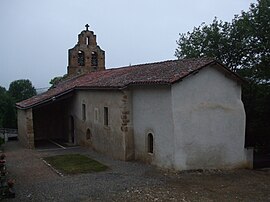Baulou
Commune in Occitanie, France From Wikipedia, the free encyclopedia
Commune in Occitanie, France From Wikipedia, the free encyclopedia
Baulou (French pronunciation: [bolu]; Occitan: Baulon) is a commune in the Ariège department in the Occitanie region of south-western France.[3]
Baulou | |
|---|---|
 The church in Baulou | |
| Coordinates: 43°01′01″N 1°32′03″E | |
| Country | France |
| Region | Occitania |
| Department | Ariège |
| Arrondissement | Foix |
| Canton | Val d'Ariège |
| Intercommunality | CA Pays Foix-Varilhes |
| Government | |
| • Mayor (2020–2026) | Nathalie Esquinol[1] |
Area 1 | 14.62 km2 (5.64 sq mi) |
| Population (2022)[2] | 165 |
| • Density | 11/km2 (29/sq mi) |
| Time zone | UTC+01:00 (CET) |
| • Summer (DST) | UTC+02:00 (CEST) |
| INSEE/Postal code | 09044 /09000 |
| Elevation | 393–655 m (1,289–2,149 ft) (avg. 490 m or 1,610 ft) |
| 1 French Land Register data, which excludes lakes, ponds, glaciers > 1 km2 (0.386 sq mi or 247 acres) and river estuaries. | |
The inhabitants of the commune are known as Baulouais or Baulouaises.[4]
Baulou is located in the Pre-Pyrenees in the Plauntaurel Mountains and a part of the Parc naturel régional des Pyrénées ariégeoises some 12 km south by south-west of Pamiers and 6 km north-west of Foix. Access to the commune is by the D1 road from Vernajoul in the south-east which passes through the commune and ends in the village. The D11 branches from the D117 south-west of the commune and passes through continuing north-east to Loubens. The D1a branches off the D11 in the commune and goes north-west to Aigues-Juntes. Apart from the village there is the hamlet of Clarac in the commune. The commune is mainly forest with some farmland along the D1 and in scattered parts.[5][6]
The Ruisseau d'Argentat rises north of the village and flows towards the north-west into a small artificial lake before continuing north-west to join the Lèze north-west of Aigues-Juntes. Many streams feed the left bank of the Ruisseau d'Argentat including the Goute de Chenaut which also forms the north-western border of the commune, the Freyché, the Goute de Tariol, the Goute du Peyfourcat, and the Goute du Gouas. The Ruisseau de Carol flows from the south to the village then continues north to join the Ruisseau de la Plaine north of the commune. The Fajal rises in the north-east of the commune and flows south.[5][6]
Baulou appears as Boulou on the 1750 Cassini Map[7] and the same on the 1790 version.[8]
In 1901, during the building of the Foix - Saint Girons railway a mammoth was discovered and called the "Mammoth of Baulou" by the scientific community.[9] It was displayed in the hall of the Château de Foix departmental museum[10] before being transferred to the Parc pyrénéen de l'art préhistorique (Pyrenean park of prehistoric art) at Tarascon-sur-Ariège.[11]
| From | To | Name |
|---|---|---|
| 2001 | 2014 | Robert Baures |
| 2014 | 2026 | Nathalie Esquinol |
In 2017 the commune had 168 inhabitants.
|
| ||||||||||||||||||||||||||||||||||||||||||||||||||||||||||||||||||||||||||||||||||||||||||||||||||||||||||||||||||
| |||||||||||||||||||||||||||||||||||||||||||||||||||||||||||||||||||||||||||||||||||||||||||||||||||||||||||||||||||
| Source: EHESS[13] and INSEE[14] | |||||||||||||||||||||||||||||||||||||||||||||||||||||||||||||||||||||||||||||||||||||||||||||||||||||||||||||||||||


Seamless Wikipedia browsing. On steroids.
Every time you click a link to Wikipedia, Wiktionary or Wikiquote in your browser's search results, it will show the modern Wikiwand interface.
Wikiwand extension is a five stars, simple, with minimum permission required to keep your browsing private, safe and transparent.